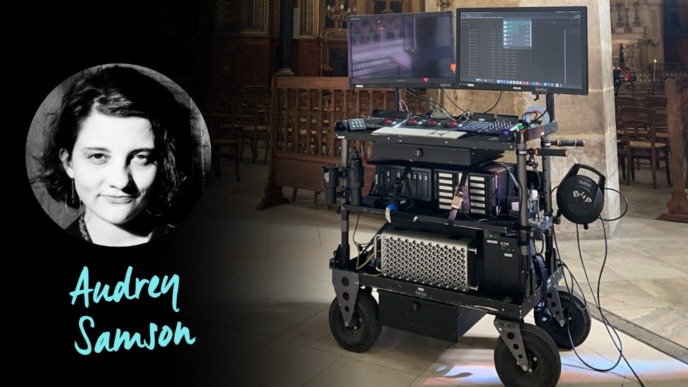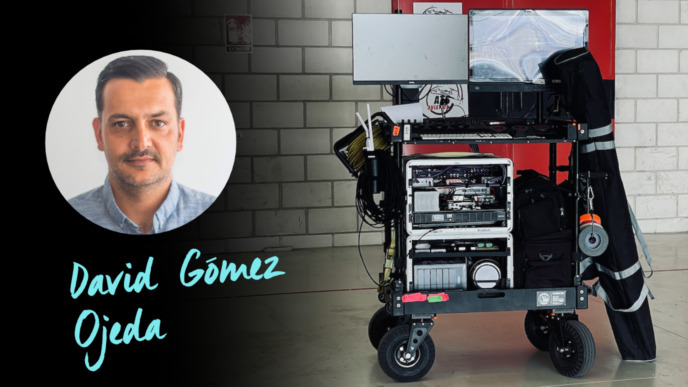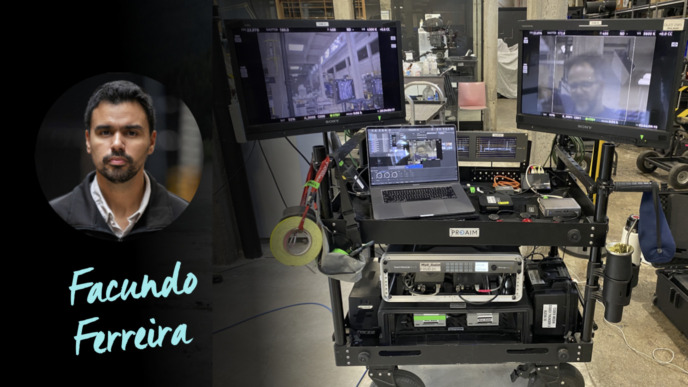
Before joining Mission Digital, a UK-based DIT and digital dailies services company, Lucy worked as an on-set editor, juggling many different responsibilities at once. These days, she’s fully focused on her role as a near-set and on-set DIT for diverse projects. Besides loving the tech side of things, it’s the interactions on set and personal touches of her DIT cart that Lucy cherishes most. Keep reading for an exclusive interview about her gear, setup, and overall work!
First of all, thanks so much for this interview! To start, could you please tell us a bit about yourself and your professional life?
I started off working as a freelance editor while I was studying at University. Back then, the job role of “DIT” wasn’t something really spoken about; it was never a job I actively pursued or even knew I could pursue. For the vast majority of my work in the early days, I was editing on set, so the responsibilities of data management and colour grading everything was on my shoulders. I was my own DIT, editor, and colourist (which I wouldn’t recommend to anyone).
A couple years ago, I joined the Mission Digital team as one of their near-set talents and have now almost completely dedicated my attention to the DIT role. I don’t think that would have been possible without the help of the team at Mission.
So now as part of the Mission Digital team, what kind of projects are you usually working on?
Being a near-set DIT, my work mainly consists of managing data, transcoding, and balancing the footage in terms of colour correction after everything has been offloaded.
The last year has really blown up the variety of projects I’ve worked on, from music videos for the one and only Teletubbies, to data managing on the second unit for Willow, and at the time of writing this, DIT on block 2 of The Lazarus Project season 2.
We know that every DIT’s setup varies. Overall, how would you describe yours?
I work with rigs from Mission Digital. Their setups vary depending on the job’s requirement but also they try to make sure that the rig works well for each technician. Due to the work that we do, we often need quite a lot of kit. As I’m transitioning from near-set work to more on-set work as of late, one thing I can say about the rig is it’s not best suited for the weak-armed. Everything I use is able to fit onto a single Magliner, so it’s incredibly easy to up and move when the need arises. However, stairs are becoming my mortal enemy.

Could you walk us through the bits and pieces of your setup?
Since working with Mission Digital, I have upgraded my setup from being tucked in a small corner with a laptop to a more hefty rig – which does mean I’ve had to abandon my small nooks that I used to be able to hide in. I work off a fairly small Magliner; all the essentials I need are bolted into place and secure. As I mentioned, the setup always varies depending on the specifics of the job and what the workflow looks like. Every job is different, so it’s important to be adaptable. It’s always about making sure I have the right equipment, the right power, and the right backup.
But normally, I use two monitors, a standard desktop monitor and then a Grade 1 monitor for grading and viewing the live feed. The monitors are on C-stands that have been bolted to the floor of the Magliner and two holes drilled through the top shelf. Other features include a UPS, which I can’t recommend enough, a Raid 5 hard drive, and the Mac I work off. In terms of power, I usually run off a generator provided by production; however, my next purchase will be a couple of EcoFlow batteries, so I’m self-sufficient.
What has been the latest addition to your setup?
The latest upgrade for me is moving from the Mac Pro, or as I lovingly refer to it, the “trash can”, to a Mac Studio. I also recently bought myself an Atomos Shogun 7, and I swear by it now. It’s been really helpful, especially when working with multiple cameras. The Flanders monitor only has two SDI inputs, so I used to spend a lot of time switching out cables. With the four SDI inputs on the Shogun 7, I can switch with the simple tap of a screen. It also lets me record the screen, so playback has been a breeze, and being able to record rehearsals has been so useful.

Personally speaking, what’s your favorite component of your setup?
If I were to give a tech-based answer, the toss-up would be between Silverstack and DaVinci Resolve. Regardless of whatever rig I’m on, even if I were to go back to working on a laptop tucked away in a corner, I know I can do my job (as a near-set DIT) as long as I have those two pieces of software in my arsenal. I used to work with ShotPut Pro 5, but since Mission Digital started providing me with Silverstack on jobs, it completely changed my perspective on data management. Since switching over to Silverstack, the amount of information I am able to accumulate, the speed with logging footage, and the cleanness of how it operates have improved my work tenfold.
I’d love to be more technical here, but honestly, that wouldn’t be true. So coming back to your question: The favourite bits of my rig are the little home touches like my portable desk lamp or the side satchel – little things like that which give a bit of home comfort. I enjoy the personal touches that accumulate when working, and each rig gets its own completely unique flourishes. I’ve had camera tape borders that have decorated previous rigs with, fairy lights and little toys that have been gifted to me. The trinkets that are given to me while on a job always brighten my day and make each job unique.
Has your setup been involved in any notable stories that you’re willing to share with us?
Most notable stories I can think of involve the anarchy that has happened while trying to get my rig into the most awkward of locations. Back on Willow, we had to get the DIT rig up a muddy near vertical hill that was so muddy even the gator vehicles the locations team had gotten were slipping backwards trying to make their way up. We got there in the end, and I can’t complain too much. The location was absolutely beautiful, and getting the rig back down was a much easier feat.
There’s also the many chaotic and uniting times where crew members have helped me get my rig up the stairs. As I said earlier, stairs are the bane of my existence. Data managing can be a very isolating job role, so seeing people come to help you out when they have no obligation to do so is a very touching gesture that means a lot to me.
__________________________
Big thanks to Lucy for sharing al these insights with us!

Lucy Keal , DIT
Lucy is a UK-based DIT. As part of the Mission Digital Team, she’s working as an on-set and near-set DIT for diverse TV and film projects.



